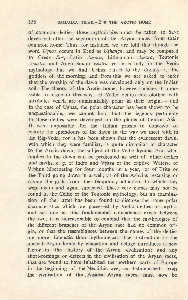Page 575 - Lokmanya Tilak Samagra (khand 2)
P. 575
356 SAMAGRA TJLAK- 2 • THE ARCTIC HOME
of common deities, these mythologies must be taken to have
developed after the separation of the Aryan races from their
common home. Thus, for instance, we are told that though the
word U~has occurs in Zend as U~hangh, and may be compared
to Greek Eos, Latin Aurora, Lithuanian Auszra, Teutonic
Asustro and Anglo-Saxon Eostra yet it is only in the Vedic
mythology that we find U ~has raised to the dignity of the
goddess of the morning; and from this we are asked to infer
that the worship of the dawn was developed only on the Indian
soil. The theory of the Arctic home, however, makes it impo-
ssible to argue in this way. If Vedic deities are clothed with
attributes which are unmistakably polar in their origin,- and
in the case of U ~has, the polar character has been shown to be
unquestionable,-we cannot hold that the legends pertaining
to these deities were developed on the plains of Central Asia.
It was impossible for the Indian priests to conceive or
picture the splendours of the dawn in the way we meet with in
the aig-Veda; for it has been shown that the evanescent dawn,
with which they were familiar, is quite dissimilar in character
to the Arctic dawn, the subject of the Vedic hymns. And what
applies to the dawn can be predicated as well of other deities
and myths, e. g. of Indra and Vptra or the captive Waters, of
V i~h~u hibernating for four months in a year, or of Trita or
the Third going down in a well, or of the Ashvins rescusing or
saving the gods from the temporary affliction to which they
were again and again subjected. These very names may not be
found in the Celtic or the Teutonic mythology, but an examina-
tion of the latter has been found to disclose the same polar
characteristics which are possessed by Vedic deities or myths;
and so long as this fundamental coincidence exists between
the two, it is unreasonable to contend that the mythologies of
the different branches of the Aryan race had no common ori-
gin, or that the resemblances between the names of the deities
are more lingustic than mythological. The destruction of the
ancient Aryan home by glaciation and deluge introduces a new
factor in the history of the Aryan civilisation; and any
short-comings or -defects in the civilisation of the Aryan races,
that are found to have inhabited the northern parts of Europe
in the beginning of the Neolithic age, as distinguished from
;the civilisation of Ule . Asiatic Aryan races, must now be

